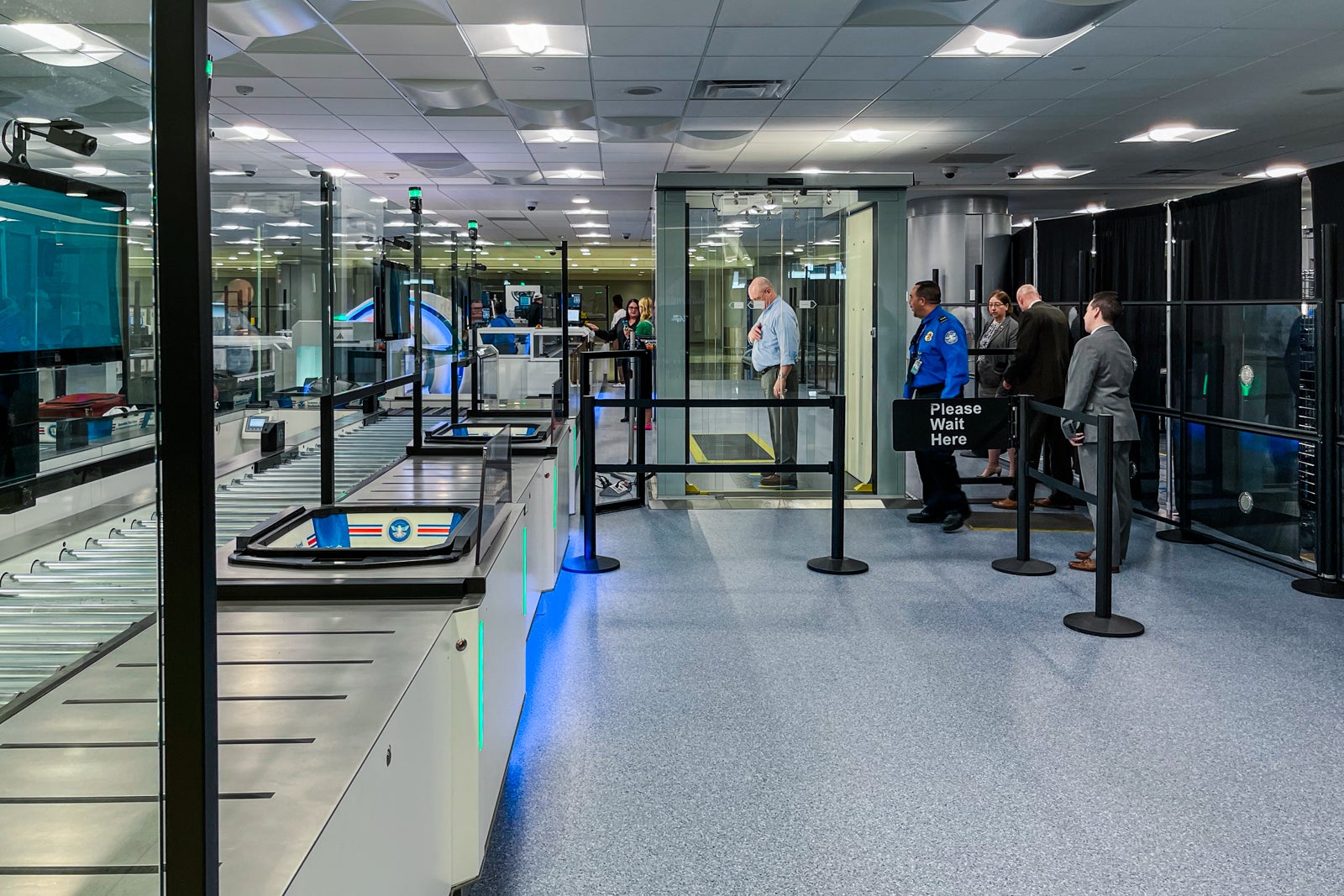TSA unveils new self-service checkpoint prototype in Las Vegas
The Transportation Security Administration is trying out a completely new checkpoint concept that its leaders liken to visiting the self-checkout station at the grocery store.
On Wednesday, the agency unveiled its new “self-service screening system” at Harry Reid International Airport (LAS) in Las Vegas. And TPG was there for a behind-the-scenes tour.
A prototype in the earliest stages of testing, the new checkpoint concept will be available to a limited number of TSA PreCheck passengers passing through Las Vegas over the coming months.
The setup requires fewer agents and little (if any) passenger interaction with TSA officers; imagine passing through a checkpoint without hearing one verbal reminder on what you need to do with your cellphone or backpack.
A pilot program, it’s nowhere near appearing at other airports. But feedback the agency gets from the first wave of users could help shape the future airport security experience, leaders said at a news conference unveiling the concept.
“It is our first foray into changing how we do things. And so, it’s a bit of an experiment,” said Dimitri Kusnezov, the U.S. Department of Homeland Security undersecretary for science and technology.
Early stages concept
Don’t expect to see this “self-service” technology on your next trip. Unless, of course, you’re flying out of Las Vegas in the near future, are a TSA PreCheck member — and are in the right terminal at the right time of day.
This setup is, for now, one of a kind, housed on Level 0 of Las Vegas’ Terminal 3 inside the TSA’s “Innovation Checkpoint” — its real-life sandbox for testing new concepts.
And though you’ve now heard the terms “prototype,” “experiment” and “sandbox” used, make no mistake: This concept was developed, the TSA said, with all of its rigorous screening and safety requirements in mind, at its Systems Integration Facility in Arlington, Virginia.

Daily Newsletter
Reward your inbox with the TPG Daily newsletter
Join over 700,000 readers for breaking news, in-depth guides and exclusive deals from TPG’s experts
The concept is the product of a joint partnership between the DHS’s Screening at Speed Program and the Transportation Security Laboratory with TSA’s Innovation Task Force.
An idea that started on a whiteboard some five years ago, it progressed to the agency penning its first government contracts for various aspects of the prototype in 2021.
And come Monday, this high-level experiment will begin in earnest.
Between 5:30 a.m. and 1:30 p.m., PreCheck passengers departing from Vegas’ Terminal 3 may have the option to use this new, ground-floor self-service checkpoint.
The agency is intently curious about what travelers will think of the experience.
“This is kind of like speed-dating. The public sees the system, the system sees the public,” said John Fortune, a program manager for the project at the DHS’s Science and Technology Directorate. “We’re going to learn so much.”
How the TSA self-service security checkpoint works
This futuristic TSA checkpoint has what looks like two lanes — each with three “stations.”
Dropping your bag and belongings
At each of those stations, bins for belongings pop out.
Near eye level, you’ll find a screen displaying instructions. It’s motion-activated, so the prompts will begin as soon as it senses you’re there.
You’ll put your bags and belongings in bins. The screen will instruct you to slide the bin forward, so it can then move down the conveyor belt to be screened.
Have a question or need assistance? There’s a help button on the touchscreen. When you click it, a live agent who’s stationed remotely (but near the checkpoint) will appear on-screen to assist.
I tried clicking the help button, and an agent appeared within a matter of seconds.
“Seamless is a lot of what we’re going for,” said Christina Peach, a deputy assistant administrator at the TSA.
Unlike the traditional, single-file lines common at today’s checkpoints — where one passenger needing a bit more time can delay the entire line — you can proceed as soon as your belongings are in bins and on their way.
“I get to move at my own pace. And when I’m ready, I push my bin forward, and I move on,” Peach explained in an interview with TPG. “So, if the person behind me or in front of me needs a little more time, that’s OK. They can take their time, and I’m not held up by it.”
Entering the scanner
Then it’s time for you, the passenger, to be scanned.
The checkpoint uses a new advanced imaging technology scanner with entry doors on one side and exit doors on the other.
Once you walk in, an avatar will give you real-time feedback on how to stand, position your arms and such.
If there’s a problem — maybe you forgot to take a cellphone out of your pocket — it will instruct you to walk back out, correct the issue and try again — no alarm bells or pat-down.
After three unsuccessful attempts, an agent will come over to assist; yes, there will still be agents stationed at the checkpoints. But the whole process figures to be less labor intensive.
Today, around a dozen TSA officers patrol two lanes, the agency said Wednesday. This new setup may require as few as five to eight agents per two lanes, the TSA said, though time — and testing — will ultimately tell.
Reclaiming your bag
After a successful scan, the exit doors will open and you can head to collect your baggage, which is scanned by the TSA’s computed tomography machines.
As at many current checkpoints, your bag may head straight to you on the conveyor belt or to an agent if it needs further inspection. But with this setup, there’s a third option: a conveyor belt that can take your bag back around to be rescanned, eliminating the need for agents to lug heavy bags back around for rescanning.
That, Kusnezov told TPG, should help safety, allowing officers to focus entirely on catching the rare anomaly in someone’s bag that could threaten the safety of the flying public.
“When I see an officer carrying a big suitcase back and forth … or they’re lugging packs of trays back and forth … that’s not a good way for managing the risk that you want,” he said. “You want these guys focused.”
Feedback wanted
It’s not clear how long the TSA might operate this new checkpoint prototype in Las Vegas.
It could be a few months, or maybe a bit more. The TSA will be focused on gathering feedback from passengers and officers alike, which could figure into future decisions the agency makes about how to improve checkpoints across the country.
It’s possible the agency could huddle on improvements to this new system, and then try those out.
There are no current plans to expand the self-service prototype to any other airports. However, Peach said, it’s likely that portions of this concept could someday figure into future checkpoint designs elsewhere.
Ultimately, the primary goal from the passengers’ side is reducing friction points, she said.
“A lot of people want an experience where they can complete the screening process with minimal [TSA officer] interaction,” Peach explained. “They should be able to go through the system on their own.”
Like a grocery store self-checkout
The DHS expects an adjustment period with the new concept as passengers experience it for the first time.
With time, though, Kusnezov expects passengers to like this concept, pointing to the proliferation of self-checkout at the neighborhood grocery store.
“It wasn’t natural for a lot of people to go into there. Now I choose it even if the line looks longer … because I like to manage my own time,” he said.
Wherever this leads, it’s a major step forward as the agency works to modernize, keeping pace with rapidly evolving technology.
Already, at some airports across the country, travelers with some airlines don’t have to show an ID or boarding pass amid the expansion of biometric technology.
It’s clear more innovations are on the way.
“It’s crazy today, in what you can do that you couldn’t do five years ago. What’s going to be different in five years?” Kusnezov said. “This is a step. It’s not an endpoint.”
Related reading:

